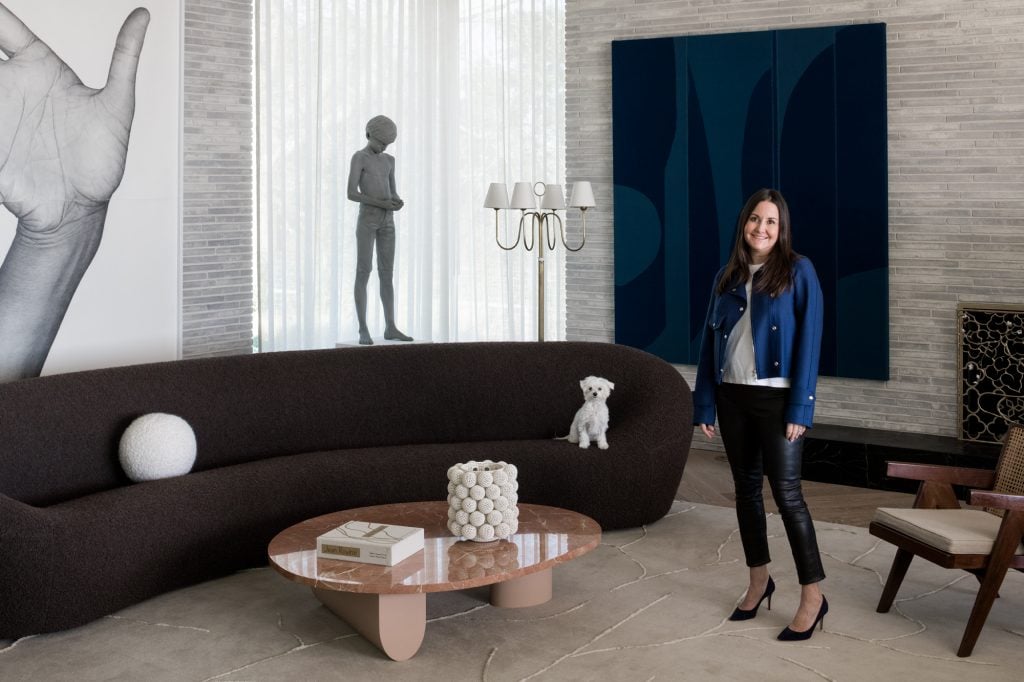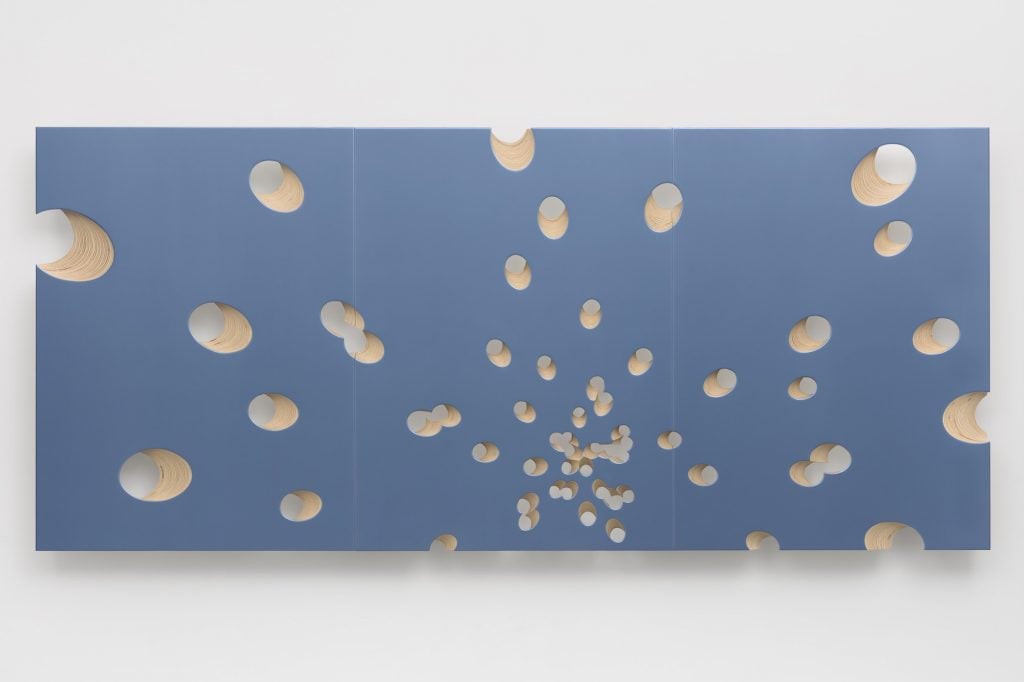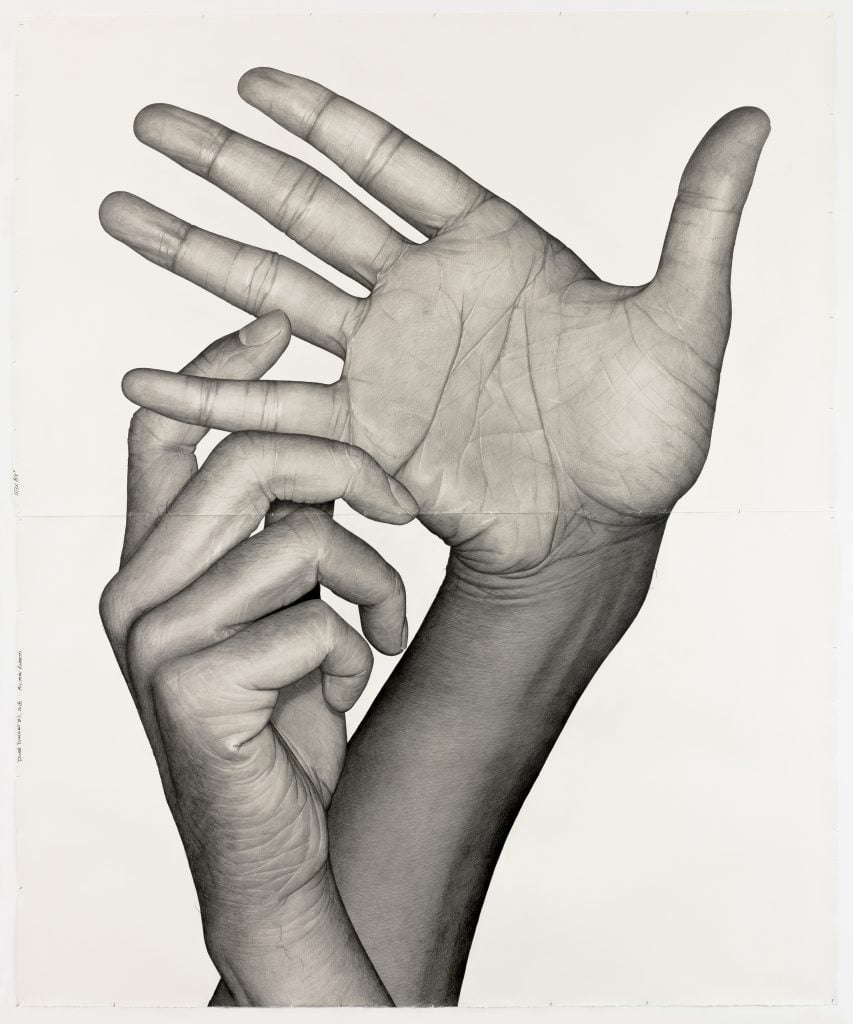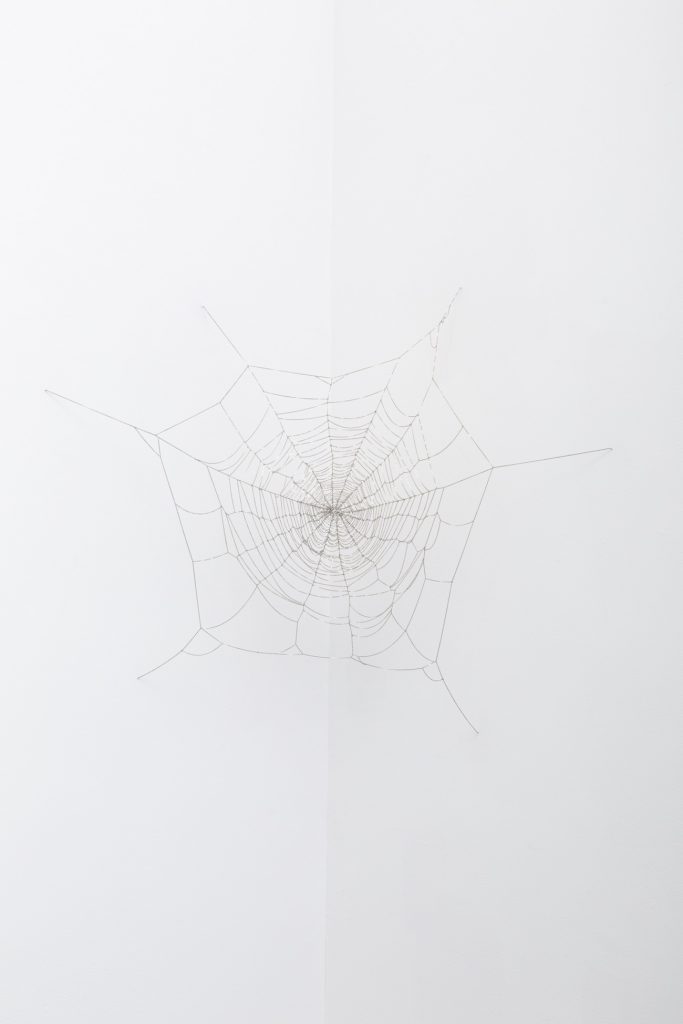Art Collectors
See Inside Lora Reynolds’s Custom-Designed Austin Home, Where Top-Flight Art Coexists With Pets, Kids, and Everyday Life
The gallerist and collector offered insight into collecting with kids and why she avoids making wish lists.

The gallerist and collector offered insight into collecting with kids and why she avoids making wish lists.

Julia Halperin

Lora Reynolds learned how to be a collector from the best. The Austin-based gallerist has sat down with greats ranging from Dominique de Menil to Ed Ruscha to witness how they live with art.
Today, she is applying the lessons she learned in a brand new, custom-built home with panoramic views designed by Stonefox, the art and design-focused architecture firm that has worked with such art-world power couples as Amy and John Phelan and Mickey and Jeanne Klein (whom Reynolds counts as her biggest mentor in art).
Inside, Reynolds lives with work by artists including Jeppe Hein, Ugo Rondinone, Sarah Crowner, Elmgreen and Dragset, Fred Eversley, and Ken Price.

Lora Reynolds’s Austin home. © Jane Beiles
At a time when some say Austin is poised to become the next big American collecting city, Reynolds is well positioned. She opened her eponymous gallery there in October 2005 after stints at Anthony d’Offay and Matthew Marks galleries in London and New York. She also serves on the board of the Blanton Museum.
Reynolds let us take a peek inside her new space and offered insight into collecting with kids, why she avoids making wish lists, and the art-historical inspiration behind her home gym.
What was your first purchase (and how much did you pay for it)?
The piece that marked the beginning of my collection was a small ink drawing of a grid by Sol LeWitt, but it was a gift from my first art-world boss. Christmas was pretty unreal for gallery staff in those days.

Donald Moffett, Lot 052021 (the air we breathe) (2021). Courtesy of the artist and Marianne Boesky Gallery, New York and Aspen. © Donald Moffett. Photo credit: Lance Brewer.
What was your most recent purchase?
I’m really excited I was able to buy the first painting from Donald Moffett’s “Gutted” series—I saw it hanging in the show he has up right now at the McNay Art Museum. These canvases are flayed and pinned back—when they’re installed, you’re looking at the backside of the canvas and the rectangle of wall behind the stretcher bars. It’s my seventh Moffett. I have a feeling there will be more. (It’s taking a lot of willpower to keep myself from buying his whole show up at my gallery right now.)

© Jane Beiles
What was your earliest encounter with art that made you want to dedicate your career to it?
I owe my life in the art world to Jeanne Klein. As I was beginning a relationship with her son, the man who would become the father of my children, she took me under her wing. When she founded the Menil Contemporaries, a young collectors’ group in Houston, I eagerly joined—and was soon floored by our behind-the-scenes tours of the famously eclectic salon-style hang of art the collection keeps in storage.
When we went as a group to see Philip Johnson’s Glass House, Philip wasn’t supposed to be there, but he joined us for lunch by surprise. These are the kinds of intimate experiences that Jeanne provided me with—the stories could go on for days—and the values I absorbed from her have helped guide my entire career. So many people are attracted to the money and fame and glitz of the art world. I am lucky and forever grateful Jeanne pointed me instead in the direction of the humility, curiosity, and deeply moving personal relationships that can come with a life in art.
Carol Mancusi-Ungaro’s perspective as chief conservator at the Menil helped shape my perspective on collecting, too—thanks to her, I try to avoid thinking of myself as owning any of the artworks I am lucky enough to live with. I am merely a steward, temporarily caring for these objects that really belong to the next generation.

© Jane Beiles
Which works or artists are you hoping to add to your collection this year?
I have my eye on a Hiroshi Sugimoto Diorama—a black-and-white photograph he took in a natural history museum with an 8×10 large-format camera. At first glance, these pictures seem like they came out of the BBC’s Planet Earth—you wonder how it could be possible Sugimoto captured such a dramatic moment in an animal’s life at such close range. You have to look much closer before it clicks that the animals are taxidermied, the backdrops painted—it’s all staged and stationary.
I have three Ken Price drawings and always want more—and too many pieces to count by the Haas Brothers, Tony Marsh, Kay Rosen, Arlene Shechet, and Michelle Stuart. When I love the work and the person who makes it, I like to buy as much as I can.
But I don’t really make wish lists. Whether a piece is by someone I’ve followed for years or an artist I’ve never heard of, I look to be shaken to my core—and then I honor that feeling and say YES!

© Jane Beiles
What is the most expensive work of art that you own?
The most special thing in the collection might be a painting Alex Katz made of me in 2001. I sat for him one afternoon, somebody bought the painting, and I never saw it again until I heard it was coming up at auction 10 or 12 years later. I never really thought it looked much like me (and I don’t usually like images of myself!), but it’s uncanny how much it looks like my daughter Georgia.
What is your advice to collectors who are nervous about mixing art and children at home?
It’s easy to talk yourself out of buying art you worry is too challenging to live with. Be bold! Teach your kids to play catch outside and train your pets to be polite. We have a Briard, a Maltese, and two Ragdoll kitties; my kids have spent their entire lives around fragile objects. There has definitely been an errant lacrosse ball flying through the house on occasion (cannot recommend), and not all of my animals are always perfectly well-behaved—but for the most part, you’ll be surprised how grown-up kids and animals can be if you give them the chance.
I’ve used living with art as an excuse to start talking to my kids—early!—about how culturally important contemporary art has always been to humans. It’s one of the ways we understand who we are and where we come from and where we might be going. When things go wrong (and they will!), a good conservator can be a miracle worker.
The C.S. Lewis quote about locking up your heart comes to mind: “But in that casket, safe, dark, motionless, airless, it will change. It will not be broken; it will become unbreakable, impenetrable, irredeemable. To love is to be vulnerable.”
Where do you buy art most frequently?
Galleries. I like supporting living artists—buying work from galleries means artists get to pay their bills and keep doing what they want to do.
Is there a work you regret purchasing?
No regrets—just new perspectives.

Karl Haendel, Double Dominant 3 (Miljohn Ruperto) (2018). Courtesy of the artist and Vielmetter Los Angeles. Credit: Robert Wedemeyer.
What work do you have hanging above your sofa? What about in your bathroom?
A nine-foot tall Karl Haendel drawing of another artist’s hands is above the Pierre Paulin sofa in the great room.
A small, sky-blue, extruded Donald Moffett painting projects out of the wall above the Finn Juhl sofa in the bedroom.
An unframed Paper Drop by Wolfgang Tillmans is pinned above the sectional in the playroom.
A big, powerful watercolor of a sunshower by Thiago Rocha Pitta lives over the couch in my son Wilder’s room.
My favorite room in the house might be the powder bath. Plastered walls are deep blue, a gold-leafed photograph by Jim Hodges hangs next to a crystal-lined vintage mirror by Palwa and four minimal wall lights by Charlotte Perriand.

© Jane Beiles
What is the most impractical work of art you own?
I just bought a giant Martin Creed sculpture. It’s the word “MOTHERS” in white neon—40 feet wide, eight feet high, eight feet off the ground—and it rotates. We’re working on shipping it to Texas from London and the logistics are already more formidable (by several orders of magnitude) than anything else I’ve ever dealt with. I love it so much, though. I knew right away that jumping through the many ridiculous hoops of getting this piece installed would be nothing compared to the trials of actual motherhood. Seems an important part of how the piece pays tribute.
What work do you wish you had bought when you had the chance?
In 1995, I sat down with Ed Ruscha in his studio and we went through a couple hundred of his drawings together. All sorts of things—some were from the 1950s, some he had just finished. If I had had the means then, I would have told him I wanted every single one.
If you could steal one work of art without getting caught, what would it be?
Vermeer’s Study of a Young Woman at the Metropolitan Museum of Art. Twombly’s chalkboard paintings at the Menil Collection. Charlie Ray’s Boy with Frog. A Cycladic figure. Ed Ruscha’s Mañana. No way I can choose just one—sounds like I need to put together a team!

Jim Hodges, Again and Again (2001). © Jim Hodges, courtesy of the artist.
You worked with the architecture firm Stonefox to design your new home, drawing on your many years of traveling and viewing art at fairs, auctions, and biennials. Is there a particular installation or two you saw on your travels that had a big impact on how you installed your art at home?
Chris Stone and David Fox [principals at Stonefox] organized a trip to Paris I so loved—one of the highlights was seeing Maison de Verre, a live/work space commissioned in the 1930s by a progressive gynecologist. The glass block façade of that house served as the inspiration for my home gym, maybe the most prominent feature of the new house on approach. In the evening, the glass box emits a soft glow of light. A small part of me worries it’s a little gratuitous (inner radiance eye-roll), but I love the history it channels—I am an ardent supporter of reproductive rights—and I’m so enchanted by its beauty, I sometimes wonder if I’m part moth.
If you look hard enough at art fairs, auctions, or biennials, you can generally find little moments of magic—but on the whole, I don’t find them to be terribly inspiring spaces. Too much bustle, too much commercialism, not enough thoughtfulness/subtlety/tranquility—I’m not trying to model my personal relationship to art on that kind of frenetic energy!
I’m much more interested in the glimpses I’ve had of how other people live with their own collections. Spending time with Dominique de Menil in her home—grappling with her voracious appetite for culture and history and art from such a wide range of people and places and times. The understated elegance of Edward and Agnes Lee’s collection in London. The thrift-store paintings in Ed Ruscha’s Santa Fe house.

© Jane Beiles
But maybe most influential of all has been watching Glenn Fuhrman’s tastes and ambitions evolve over the last 25 years. We’ve been close friends from the days when he first started collecting prints. There were many years when I would ask Glenn for his thoughts on almost every artwork I was considering buying. His passion for art comes from his deep love for artists and how their unique perspectives on the world can help inform his own. The most meaningful artworks in my own home are all tied up with my own relationships with artists and the experiences I’ve shared with them over the years. My collection helps me know myself and reminds me of the people and ideas I hold dear.